Niveditha Ajay
“It is that sense of looking into another world that’s so fascinating about art in the first place.” Notes British painter, Cecily Brown while talking about the inspiration behind her pieces to The Met. With a unique style obtained through unrestrained experimentation, Brown has cemented herself as one of the finest artists of her generation. Bursting with colour and abstraction, her paintings retain the form in the most incredible ways- emerging bodies, lavishly unsettling feasts, animals, and mirrors make up a significant portion. Their capability to convey form while remaining free from the confines of harsh lines and restricted boundaries has received praise from critics and viewers alike.
Born in London and raised in suburban Surrey, England, Brown holds a B- TEC Diploma in Art and Design from the Epsom School of Arts, has taken printmaking lessons from the Morley College, also has a B.A. in Fine Arts from the Slade School of Art, London. Her diverse skill set (that includes animation and printing) as well as her experience training under Maggi Hambling have been influential to her work. Beginning in the 1990s, Brown’s work has evolved in figure, size, and concept. While part of the generation of Young British Artists, she never joined the movement as she did not align with the concepts. Her eventual relocation to New York, where she still resides, too has a role to play in her work.
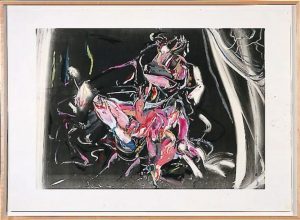
Courtesy: Gagosian
Brown, in her art, combines a deep understanding of the body and its interaction with the environment around it. One of her earliest pieces, titled “The Skin Game” (1999), displays an array of tangled forms including a pink dismembered leg wearing blue shoes, juxtaposed against a black background. The imagery of bodies and the poignant sensuality associated with them is a recurring theme in her paintings. In her recent works such as The Girl and the Goat (2013-2014), and even older ones like Aujourd’hui Rose (2005) the woman and the images that surround the woman’s body have key roles. The body is not simple- it requires deconstruction as she swings between abstraction and figuration. As the artist herself mentions, the influence of formation in Pollock’s paintings and the large gatherings recorded in the work of El Greco is to be seen in the “teeming” arrangement of hands, faces and complete bodies that seem to all at once emerge and fade into the background of her paintings. The frenzied mind and the fragmented yet cohesive thought seem to be conveyed through both the physical and the immaterial in her pieces.
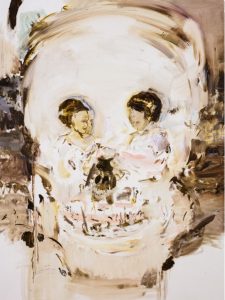
Courtesy: artnet
The fluidity of her paintings and their freedom from structure have only increased over the years of her work. This experiment has led to the addition of optical illusions, double imagery and motifs of conscious significance in her work. In The Only Game in Town, the image can both be viewed as an old woman or a young half-turned face, which she describes to be the wife and the mother-in-law. Similarly, the double image exists in her work Aujourd’hui Rose which can be viewed as two girls sitting or as a skull. The fascination in these pieces arises from the constant tussle that the viewer undergoes, oscillating between the various views while being unable to see them at once, simultaneously. Brown describes these works, particularly the latter, as her attempts to view youth in death, or death itself at a distance. Adding to the play on image comes Brown’s fascination with mirrors, over the years she has produced several works where the mirror adds to the narrative. The many renditions of the concept of ‘woman looking into the mirror’ that Brown has painted showcase her endless fascination with playing between the worlds- as she describes, the world that exists within the mirror and the world that the mirror reflects.
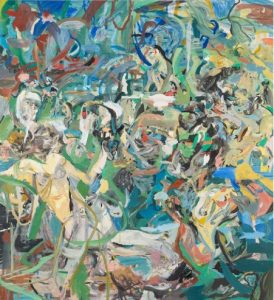
Courtesy: Gagosian
The process and progress Brown has made over the years in her painting style have been commented upon extensively. From a widening scope and theme to a varied palette of colours entering, the growth and transition of an artist are evident in Brown’s work. Remarking on her process, Gagosian reveals the use of improvisation in her paintings- often beginning with a stroke and allowing the painting to grow from it. Landscapes too started finding a place in Brown’s later art. Art history and pop culture also, are sources of inspiration. As an artist, she is known for going back and reworking her older paintings- allowing them to be layers of both the old and the new, evolving with her. For her smaller paintings, the process involves working on multiple ones at the same time.
Brown’s ongoing exhibition at The Met in New York, titled “Death and the Maid”, is a stunning display of her prowess and signature as a painter. The Director of The Met, Marina Kallen, describes the exhibition as, “…Brown engages with both contemporary culture and time’s eternal passage, exploring themes of desire, power, and mortality…”. Displaying her work from across a 25-year-old career, the vivid dynamism and provocativeness of Brown’s art are preserved. Running from 4 April 2023- 3 December 2023, the exhibition showcases over 50 paintings, sketches, drawings and even recently completed work. Some iconic pieces and themes too are part of the show.
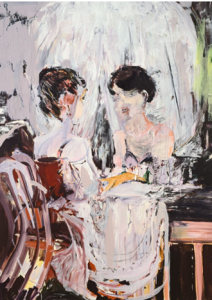
Courtesy: artnet
According to The Met, the show revolves around two primary and interlocking themes. The first is the above-discussed concept of double imagery. The looking glass and optical illusions contribute heavily to this aspect, with other works in the collection like Untitled (Vanity) (2005) and Fair of Face, Full of Woe (2008) also making use of the themes. The pun does not end with the visual alone, but in the duality constructed- “be both representational and abstract, moralizing and sensuous, and referential and consistently innovative at the same time,” (The Met). The second theme that Brown’s art contains is still life and the centrality given to objects and the spaces they occupy. Inspired by the abundance displayed in Flemish artists’ work- both in extravagant feasts as well as in the richness of hunt paintings, Brown has created pieces such as Nature Morte and Lobsters, Oysters, Cherries and Pearls (both 2020). These works contrast the flamboyance and excessiveness of the hunt with the grotesque within.
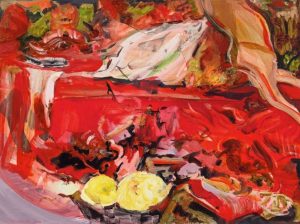
Courtesy: artnet
Brown is a celebrated artist of the contemporary generation, with her willingness to explore and evolve, she has created work that is sensual to the soul and stimulating for the mind. The madness of colour and the intricacy of layers in her pieces are symbolic of both the existence and absence of restriction. The beauty in her art lies within its candid nature of it- creating spectacles open for interpretation and the sheer brilliance that defies convention, choosing to instead depict contradictions, collisions, and convergence.
SOURCES
https://gagosian.com/artists/cecily-brown/
https://gagosian.com/artists/cecily-brown/
https://www.metmuseum.org/perspectives/videos/2023/3/cecily_brown_interview





